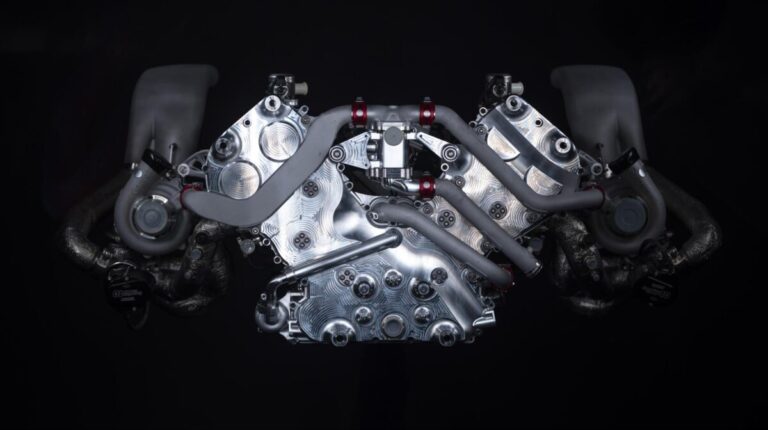The Genesis GMR-001 hypercar’s V-8 twin-turbo engine has completed a successful first fire-up at Hyundai Motorsport’s headquarters in Frankfurt and is preparing for future tests. Described by Genesis Magma Racing team principal Cyril Abiteboul as the first “heartbeat” of the project, the test marked a key milestone in the development of the engine and for the GMR-001 hypercar. The GMR-001 is due to take Genesis Magma Racing into the FIA World Endurance Championship (WEC) in 2026.
Hyundai Motorsport experience behind engine development
Overseen by Hyundai Motorsport’s head of powertrain, Julien Moncet, and engine workshop leader Rob Benson, the fire-up procedure took place in late February.
“Hyundai Motorsport is the backbone of Genesis Magma Racing, and the development of the engine for the GMR-001 hypercar is the perfect demonstration of this,” said Abiteboul. “We have a huge wealth of expertise at Hyundai Motorsport, so to develop the powertrain for the GMR-001, it was only natural to call on the people we have.”
Moncet added, “We have a very strong team in Hyundai Motorsport. We have everyone working on the powertrain all together, so the communication is very good between the departments, feeding information back between simulations. This can speed up the development process and it means we can immediately adapt as soon as we see something, without losing time.”
Engine design drawn from WRC
The basic architecture of the V-8 powerplant is derived from the inline-four cylinder motor that powers Hyundai Motorsport’s WRC challenger, the two units sharing roughly 60% of their parts. The inline-four engine, in turn, is based on the FIA’s Global Race Engine regulations, providing a strong and thoroughly tested foundation for the GMR-001 Hypercar’s engine.
“The inline-four engine is a very, very sophisticated, very efficient engine,” said Hyundai Motorsport technical director François-Xavier Demaison. “It’s a proper race engine, so it’s a very good base for developing an engine for WEC. Rallying is a sort of endurance race, so for an engine to the 24 Hours of Le Mans, it’s a good place to start from.
“With the time we had available to develop the engine, we immediately knew we did not have enough time to completely design a new engine from scratch. For the main part of an engine, you need a long time to design, validate, and of course, to produce. Every part needs to be tested over many kilometers, and the inline-four engine from our World Rally Championship car has already been well proven. It became the logical step to carry over as many parts as possible from the four-cylinder engine.”
Design work on the V8 engine began in June 2024 and was completed four months later. The assembly of the first engine was undertaken early this year in time for the scheduled fire-up.
“The first part of the project was to extrapolate what we knew from the WRC engine into endurance racing,” said Moncet. “And then we focused on making improvements to aspects like efficiency and reliability, design and simulation, working hand-in-hand to define the engine. The assembly of the first engine always takes a bit more time, as we pay extra attention to the details because we don’t know the engine. We had to learn and build the documentation together. It took about three or four weeks, but we completed the first fire-up exactly as scheduled.”
Further technical details of the engine and powertrain will be revealed later in the development process.
Next stage of engine Ttsting
The successful first fire-up marks the end of the first phase of development while simultaneously kicking off the next stage. The next phase will focus on completing a series of bench tests with the engine, before connecting it first to the car’s gearbox and finally to the hybrid unit common to all LMDh-specification cars.
Abiteboul expanded on the future steps for the engine development: “After the first crank and the first revs in a steady state, we will progressively add more heat into the system, performing long runs. Then with different dynos, we can test in a more dynamic way, reproducing closer the cycles that the engine will do around a race track like Le Mans. We can test equipped to the gearbox and the hybrid system until we have the full powertrain.”
Facing a relatively short period of time before the planned competitive debut for the GMR-001 hypercar at the start of the 2026 WEC season, these tests will prove critical in developing the powertrain and solving any minor issues before the start of on-track testing later this year.
In related news, the Aston Martin Valhalla is undergoing final validation on UK roads and at a track near Barcelona in Spain Click here to read the full story.


